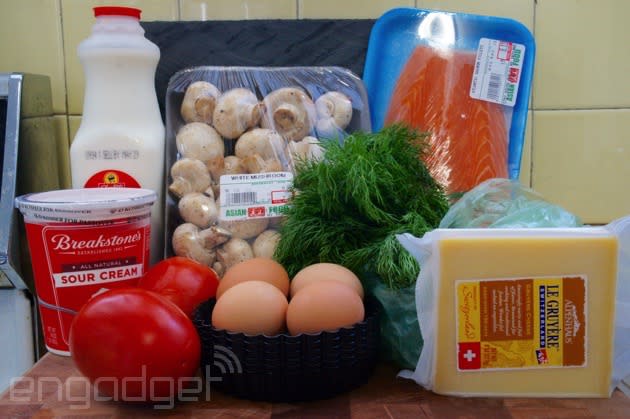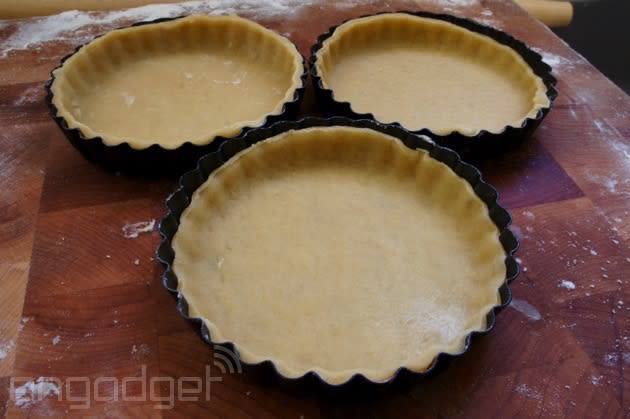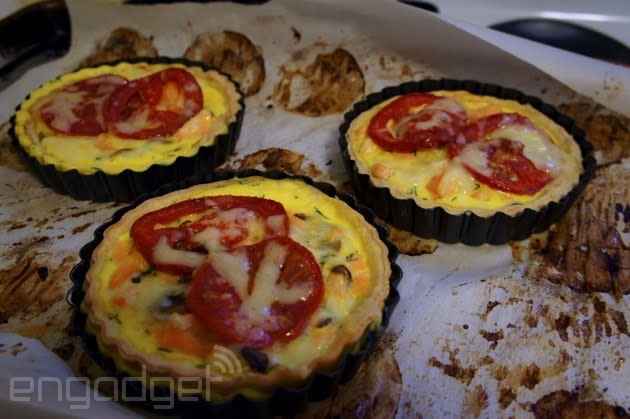Cooking with Watson: Scandinavian salmon quiche

Cognitive Cooking with Chef Watson is a collaboration between IBM and the Institute of Culinary Education in New York City. Once a week, as part of an ongoing series, we'll be preparing one recipe from the book until we've made all of them. Wish us luck.
Sometimes, the ingredient lists for these Watson recipes read like a Chopped contestant's worst nightmare.
Inside the basket you will find: tart shells, gruyere, sour cream and salmon filets.
Almost any time you mix cheese and fish, you know you're in trouble. (Update: I acknowledge that both tuna melts, and bagels with cream cheese and lox are rare exceptions to this rule.) But, if anyone is capable of taming the culinary cruelty of Watson it would be the brilliant minds at the Institute of Culinary Education, like Florian Pinel and Michael Laiskonis. So, even though the idea of a Scandinavian salmon quiche is a little off-putting, I put my faith in the human interpreters to steer me and my captive taste testers in the right direction.
There are a lot of ingredients here. And many of them go together quite well. Salmon, when smoked at least, pairs beautifully with eggs and roasted tomatoes. Dill and salmon are pretty much a match made in heaven. The Gruyère and mushrooms also play well together, and are magic when put in an omelet. But bringing all those things together sounds less like a recipe for a quiche than for chaos.

Unlike many of the other recipes in this book, all of the ingredients are readily available in your local megamart. And the techniques are about as simple as it gets. Basically the most difficult part of the process is making the dough for the shells. Pasta frolla is a pretty basic style of dough, however, that relies on the biscuit method of mixing -- cutting cold fat into your dry ingredients before mixing in the wet team. If you've ever made a dough before, this shouldn't be a huge obstacle, but you do need a stand mixer. If you don't feel like attempting the dough on your own, you could probably find a reasonable replacement in a local Italian specialty shop or maybe even a bakery.
The rest of the recipe simply involves cooking up the salmon, the mushrooms and the tomatoes. Then dumping pretty much everything (except the tomatoes) in a bowl with the eggs, mixing it together, filling the shells made from the pasta frolla and baking it.

Now, let's be 100 percent clear -- I am no chef. There is a very good chance that I simply screwed something up along the way, but my taste testers were not happy with this dish. And I can't say I was either. Gruyère is a mild Swiss cheese that often finds a home in quiche thanks to its relatively subtle flavor and great melting qualities. The problem is, that subtle flavor is kind of funky. And not P-Funk funky; like gym sock funky. You don't want to taste that alongside your salmon. More than the two not going well together (which they don't really), it's incredibly unsettling for your fish to taste like feet.
It seems like this time around, Watson might have gotten a little too out there for even the pros to tame. That cognitive spark that has made other dishes surprising in either flavor or presentation simply seems to have gone too far this time. Or maybe my palate just isn't refined enough, who knows.

Scandinavian Salmon Quiche
Pasta Frolla
2 ½ cups all-purpose flour
½ teaspoon fine sea salt
¼ cup granulated sugar
1 teaspoon baking powder
½ cup unsalted butter, cold, cut into small cubes
2 eggs
All-purpose flour, as needed for rolling
Butter, as needed for greasing ring molds
1. Thoroughly combine the flour, salt, sugar and baking powder in the bowl of an electric stand mixer fitted with a paddle attachment.
2. Add the butter and mix on low speed until the mixture resembles coarse cornmeal. The mixture should remain cool and powdery.
3. Add the eggs and continue mixing just until homogeneous dough is formed, taking care not to overwork the dough.
4. Form the dough into a flat square and wrap in plastic film. Chill for one hour.
5. Divide the dough in half (reserve the other half in the freezer for future use) and roll to a thin square on a flat, flour-dusted work surface measuring 12 x 12 inches and about ¼-inch thick
6. Cut from the dough two circles measuring eight inches in diameter and carefully line 6-inch tart rings. Arrange the rings on a parchment-lined sheet pan.
7. Blind-bake the tarts in a preheated 300-degree Fahrenheit oven for 15 to 20 minutes (just until the tart shells turn a light golden brown). Remove from the oven and cool completely.
Quiche
2 plum tomatoes, thinly sliced
Extra virgin olive oil, as needed
Fine sea salt, to taste
Freshly ground black pepper, to taste
2 tablespoons unsalted butter, divided
8 ounces salmon filet, cleaned
4 medium button mushrooms, sliced
4 eggs
½ cup plus 2 tablespoons whole milk
¼ cup plus 2 tablespoons sour cream
½ cup Gruyère, grated, divided
1 tablespoon fresh dill, finely chopped, divided
Parsley leaves, as needed
1. Arrange the sliced tomatoes on an oiled sheet pan, lightly season with salt and pepper and drizzle with an additional spoonful of olive oil. Bake in an oven preheated to 300 degrees Fahrenheit for approximately 20 minutes, until partially dried, but not browned.
2. Meanwhile, season the salmon with salt and pepper on both sides, and top with half of the butter. Gently roast in the preheated oven for 15 to 20 minutes. Remove from the oven and, once cooled, carefully flake the salmon into bite-sized pieces.
3. Heat a small sauté pan and lightly brown the mushrooms with the remaining butter over medium heat. Season with salt and pepper. Once browned, remove from the heat and cool.
4. Place the whole eggs in a bowl, whisking to combine. Add the milk, sour cream and salt to taste. Fold in the cooled salmon, mushrooms, two-thirds of the Gruyère and half of the chopped dill.
5. Divide the quiche mixture among the baked tart shells (for best results, keep the shells within the tart rings during the baking process).
6. Bake in a preheated 300-degree Fahrenheit oven for 15 to 20 minutes until partially set. Remove and arrange the dried tomato slices atop each quiche, along with the remaining Gruyère. Return to the oven to continue baking for seven to 10 minutes.
7. Remove the quiches from the oven and cool slightly. Before serving, sprinkle the tops of each with parsley leaves and the remaining chopped dill.
This recipe and others can be found in Cognitive Cooking with Chef Watson.


























